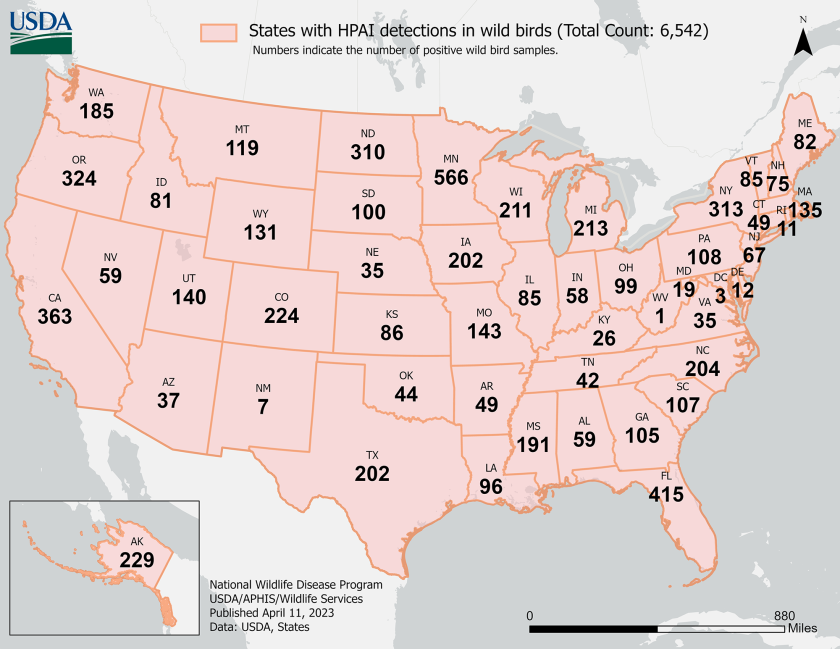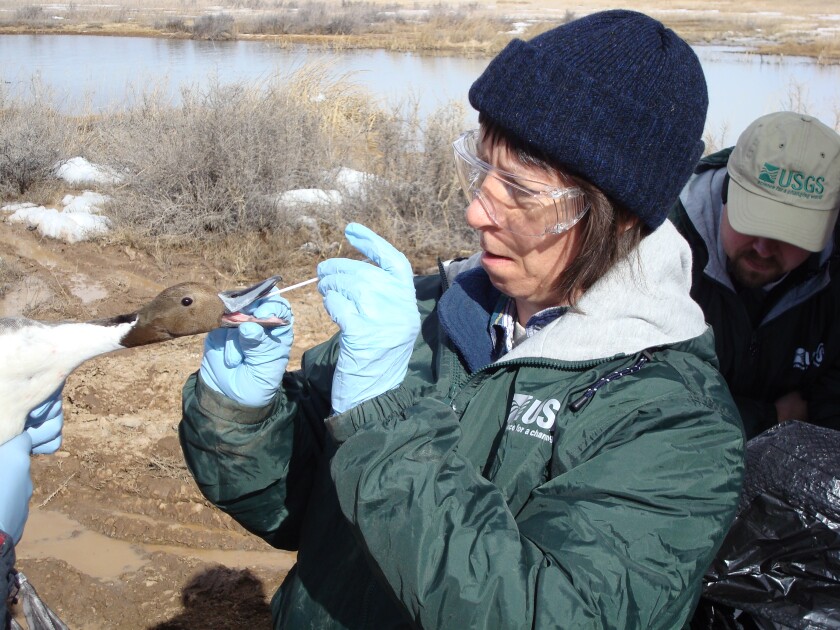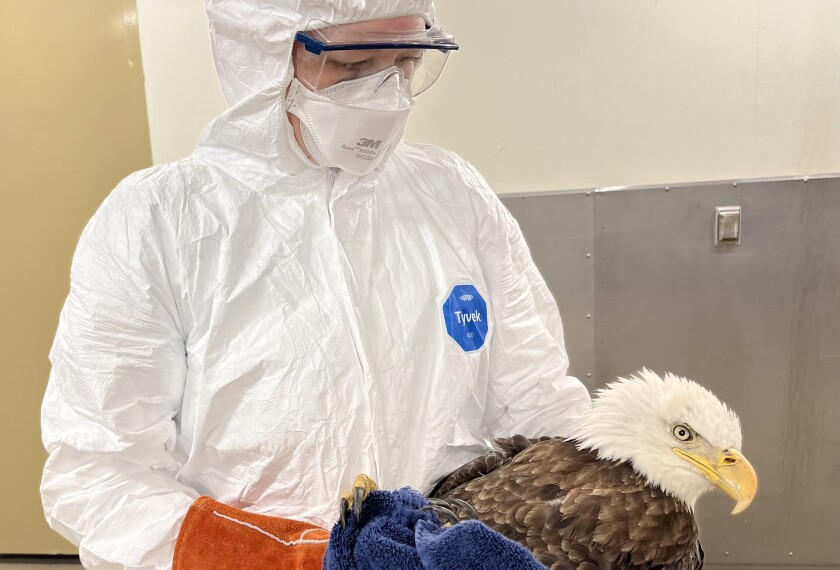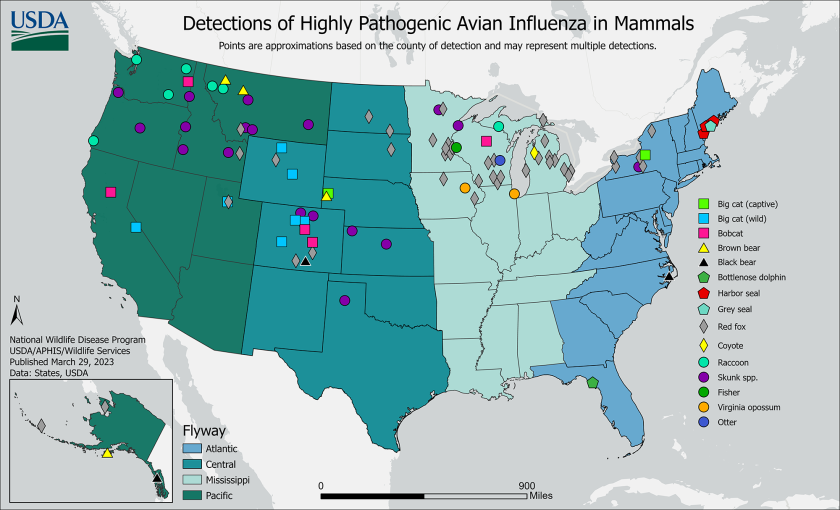DULUTH — Highly pathogenic avian influenza is back killing domestic poultry and wild birds in Minnesota again this spring as huge flocks of migratory birds carry it north for another season.
But, in fact, the deadly bird disease never left the state, even over our long winter, with birds dying in December and January and some new research showing the killer flu virus may survive even in cold Minnesota lake water — with no host bird — during the winter.
That’s the update from wildlife biologists as the great spring migration descends on Minnesota, as the snow line recedes north and ice on lakes and rivers begins to let loose.
Since the disease was first reported in Minnesota just over a year ago, some 566 birds have been tested and confirmed carrying the H5N1 strain of bird flu that’s been expanding worldwide since 2020, according to data from the U.S. Department of Agriculture. Wisconsin has had 211 confirmed cases and North Dakota 310 as of April 11.

Contributed / U.S.Department of Agriclutre
Nationally, more than 6,500 wild birds have been confirmed dead from the virus over the past year, some from all 49 continental states, although wildlife experts say that’s likely a gross under counting of the total number, most of which die and are never found by people.
ADVERTISEMENT
Minnesota has the highest number of wild birds confirmed dead from H5N1 of any U.S. state, although it’s not exactly clear why. It may be because Minnesota is a focal point for the northward migration, with many species of waterfowl and raptors — both highly susceptible to the disease — stopping over here on their way north.
Or, it could be that Minnesota has just turned in more birds for sampling than other states. Some states have had much larger die-off episodes than Minnesota, such as terns in Wisconsin and snow geese in Washington, but not all of the dead birds were tested and thus aren't officially counted.
In Minnesota, the Department of Natural Resources, U.S. Fish and Wildlife Service, wild bird rehabilitation centers and others collect fresh carcasses, responding to reports of sickly or dead birds. But no single agency is keeping track of how many are found and sent for testing by the other agencies. We only know how many positive results come back from the federal laboratory in Ames, Iowa, where testing occurs.
“We’ve asked the same question, why we are highest? ... We don’t know how many samples were collected in other states, and we don’t even know how many were collected in our state, so we don't know if we have more disease, more birds dying, or just more birds submitted" for testing, said Eric Hildebrand, the DNR’s wildlife health supervisor.

Contributed / Sumner Matteson / Wisconsin DNR
Michelle Carstensen, the DNR’s wildlife health group leader, said she’s cautiously optimistic that if birds winging north right now are bringing the same strain of influenza back with them from wintering grounds, more surviving wild birds have by now developed a resistance and this year’s carnage won’t be as great as last spring. (Domestic poultry develop little or no resistance and almost always die if they contract the disease.)
“The weaker, more susceptible birds may have died last year. And now the ones that have survived, they’ve been around it (H5N1) for a while, maybe they won't succumb to it now,’’ Carstensen said. “Of course, that's only if it's the same strain. The problem is that this disease can mutate, very quickly. And if it gets more virulent, all bets are off.”

Contributed / Robert Dusek / U.S. Geological Survey
Carstensen said that, while it’s clear the disease can impact large numbers of individual birds and flocks, there’s still no evidence — but also no real research — on the broader, population-level impact H5N1 is having on hard-hit species like snow geese, ducks and eagles.
The disease seems to flourish most in the spring, with most deaths reported in Minnesota from March into May.
ADVERTISEMENT
By late May last year, DNR officials noticed the number of wild birds reported and testing positive for H5N1 dropped dramatically, likely in part because migrating waterfowl kept flying north, out of the state, to their nesting grounds. While there was a resurgence of the virus in domestic poultry during fall 2022, biologists did not detect big impacts to wild birds in the fall and winter compared to spring 2022.
Still, birds did keep dying from bird flu in Minnesota over the winter, including four crows found dead in the Twin Cities in January. In March, a red-tailed hawk in Wright County was confirmed dead from the disease.
Bird flu hit its first domestic flock earlier this month, confirmed in a backyard poultry flock in Le Sueur County, where 114 birds were put down to prevent the disease from spreading. (Over the past 12 months, nearly 60 million domestic chickens and turkeys have been killed by the disease or put down to prevent its spread across the U.S.)

Contributed / The Raptor Center
In Minnesota and nationally, the disease hit waterfowl and the raptors that eat waterfowl especially hard. Waterfowl flock tightly and in large numbers, each infected bird shedding the disease for others to pick up. Raptors like eagles find the dead, infected fowl easy pickings.
Species impacted in Minnesota include crows, pelicans, bald eagles, barred owls, broad-winged hawks, Canada geese, common goldeneyes, loon, ravens, Cooper's hawks, dark-eyed juncos, great-horned owls, hooded mergansers, mallards, northern harriers, red-shouldered hawks, red-tailed hawks, Ross's geese, rough-legged hawks, snow geese, trumpeter swans, turkey vultures, white-fronted geese and wood ducks.
“It really seemed to hit the cavity-nesting birds like wood ducks hard last year,’’ Hildebrand noted. “We aren’t sure why.”
Across the U.S. more than 300 bald eagles tested positive and died in 2022 after eating smaller birds infected with the virus. A study reported an unusually poor eagle nesting success in avian flu hotspots in Georgia and Florida. The authors said H5N1 may pose an “impending threat” to a species only recently rescued from the brink of extinction.

Contributed / U.S. Department of Agriculture
Even more concerning to some health experts, the disease has now been confirmed in several mammals across the U.S., including foxes and skunks in Minnesota, otters and a bobcat in Wisconsin and a black bear in Colorado.
ADVERTISEMENT
Last year, only one human case of bird flu was confirmed by the Centers for Disease Control and Prevention in the U.S. during the ongoing outbreak. The case affected a commercial poultry industry worker in Colorado who later recovered. On Monday, another case was reported in a child in China.

Contributed / U.S. Department of Agriculture
Keep feeders up if you want: Songbirds largely not impacted
Despite some initial panic by a few bird lovers last spring, there’s no evidence that bird flu is an issue for songbirds. Since January 2022, the HPAI strain has been confirmed in thousands of birds nationwide with only 104 detections in wild songbirds. Transmission to songbirds and other typical feeder visitors has been low, less than 2% of all cases reported in wild birds.
According to the National Wildlife Disease Program, there is currently "low risk of an outbreak among wild songbirds," and there is no official recommendation to take down feeders — unless you also keep domestic poultry on your property. Experts do recommend that you clean bird feeders and birdbaths regularly as a way to keep several kinds of bird diseases at bay.
Bird flu does not affect all types of birds equally. The “highly pathogenic” part of the name refers specifically to the severity of the disease in poultry, not necessarily in other bird species.
For example, waterfowl often carry and transmit bird flu, and with the current strain they sometimes get sick or die. Raptors are much more sensitive to the disease. Domestic poultry are extremely susceptible leading to up to 100% mortality of affected flocks. Songbirds are much less likely than waterfowl to contract bird flu and less likely to shed large amounts of virus, meaning they do not transmit the disease easily.
Wild turkeys also not a problem
Despite its devastating impact on domestic turkeys and chickens, the current strain of bird flu poses a very low risk to people and no food safety concern for most upland birds or even hunter-killed waterfowl. During the 2022 outbreak, DNR staff tested several sick turkeys but all tested negative for bird flu. No positive cases have been reported in wild turkeys in Minnesota or Wisconsin. However, the USDA does have guidelines for hunters handling wild game, including using rubber gloves when field-dressing game and washing hands thoroughly after touching wild game birds.
ADVERTISEMENT
I’ve found a sick bird, what should I do?
Avoid handling the animal if possible. You can allow nature to take its course. While it is unfortunate, there are not any available treatments for bird flu. Raptors, in particular, die quickly after contracting this illness.
Do not attempt to care for the animal yourself. While the risk of contracting this strain is low for people, there still is a risk. Wildlife rehabilitators are trained on how to limit contact and preserve a wild animal's natural instincts while giving care.
Trained rehabilitators are able to assess the animal's condition and take necessary steps to either keep and care for the animal or humanely euthanize it if necessary. You can find a list of local wildlife rehabilitators on DNR's website or contact a local DNR wildlife office.
If you find multiple dead birds in one area
Report the finding to the Minnesota DNR at 888-646-6367. DNR biologists may be interested in recording the possible case to track the virus or some other issue.
If the biologists do not need the birds for sampling and you need to move them, wear disposable gloves, double bag the birds and place them in the trash. This will ensure other animals are unable to get to the carcasses and potentially become infected themselves.
"bird" - Google News
April 15, 2023 at 06:01PM
https://ift.tt/cy6tMp1
Minnesota tops nation in wild birds confirmed dead from bird flu - Duluth News Tribune
"bird" - Google News
https://ift.tt/re12bNP
https://ift.tt/hUxgtew
Bagikan Berita Ini














0 Response to "Minnesota tops nation in wild birds confirmed dead from bird flu - Duluth News Tribune"
Post a Comment